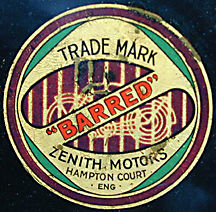
Velocette is a line of motorcycles made by Veloce Ltd, in Hall Green, Birmingham, England. One of several motorcycle manufacturers in Birmingham, Velocette was a small, family-owned firm, selling almost as many hand-built motorcycles during its lifetime, as the mass-produced machines of the giant BSA and Norton concerns. Renowned for the quality of its products, the company was "always in the picture" in international motorcycle racing from the mid-1920s until the 1950s, culminating in two World Championship titles and its legendary and still-unbeaten 24 hours at over 100 mph (161 km/h) record. Veloce, while small, was a great technical innovator and many of its patented designs are commonplace on motorcycles today, including the positive-stop foot shift and swinging arm rear suspension with hydraulic dampers. The business suffered a gradual commercial decline during the late 1960s, eventually closing in February 1971.

Brough Superior motorcycles, sidecars, and motor cars were made by George Brough in his Brough Superior works on Haydn Road in Nottingham, England, from 1919 to 1940. The motorcycles were dubbed the "Rolls-Royce of Motorcycles" by H. D. Teague of The Motor Cycle newspaper. Approximately 3048 motorcycles were made in the 21 years of production; around a third of that production still exists. T. E. Lawrence owned eight of these motorcycles and died from injuries sustained when he crashed number seven; the eighth was on order. Moving forward to 2008, vintage motorcycle enthusiast Mark Upham acquired the rights to the Brough Superior name. In 2013 he met motorcycle designer Thierry Henriette and asked him to design a new Brough Superior motorcycle. Three months later a prototype of a new SS100 was shown in Milan.
HRD Motors Ltd was a British motorcycle manufacturer in the 1920s. It was founded by Howard Raymond Davies. He had worked in motorcycling, and had raced with some success in the mid-twenties, but often not finishing due to unreliability. This inspired him to build a reliable performance motorcycle, using the advertising slogan "Built by a rider". Others also aimed at a similar market, like George Brough of Brough Superior motorcycles.

The New Hudson Cycle Co. was originally started in 1890 by George Patterson, and manufactured 'safety' bicycles in Birmingham. In 1903 they produced their first motorcycle, but times became tough for Patterson after one of his sons died in WW1 and the other lost a leg. The family sold the factory to HJ Bructon after WW1, and in 1920 the company was reformed as New Hudson Ltd.

The Cotton Motor Company, was a British motorcycle manufacturer of 11a Bristol Road, Gloucester, and was founded by Frank Willoughby Cotton in 1918. F.W. presided over the company until his retirement in 1953. The company was reconstituted as E. Cotton (Motorcycles) Ltd, and traded until 1980. The marque was later resurrected in the late 1990s by a business which manufactured replicas of earlier machines.

The 1949 Isle of Man Tourist Trophy was the first round of the Grand Prix World Championship that was held in the Isle of Man.
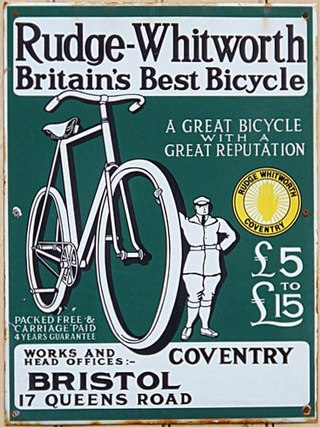
Rudge Whitworth Cycles was a British bicycle, bicycle saddle, motorcycle and sports car wheel manufacturer that resulted from the merger of two bicycle manufacturers in 1894, Whitworth Cycle Co. of Birmingham, founded by Charles Henry Pugh and his two sons Charles Vernon and John, and Rudge Cycle Co. of Coventry.

The motorcycle land-speed record is the fastest speed achieved by a motorcycle on land achieved by Martynas Kišonas. It is standardized as the speed over a course of fixed length, averaged over two runs in opposite directions. AMA National Land Speed Records requires 2 passes the same calendar day in opposite directions over a timed mile/kilo while FIM Land Speed World Records require two passes in opposite directions to be over a timed mile/kilo completed within 2 hours. These are special or modified motorcycles, distinct from the fastest production motorcycles. The first official Fédération Internationale de Motocyclisme (FIM) record was set in 1920, when Gene Walker rode an Indian on Daytona Beach at 104.12 mph (167.56 km/h). Since late 2010, the Ack Attack team has held the motorcycle land speed record at 376.36 mph (605.69 km/h).
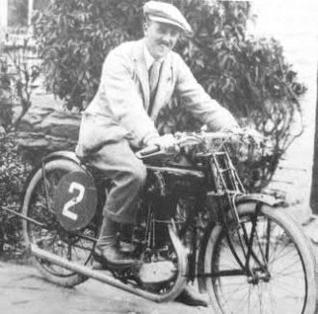
Howard R. Davies, was an English motorcycle racing champion, motorcycle designer and originator of the 'HRD' marque which later became Vincent-HRD motorcycles. He died in January 1973.

The AJS V4 started out as a prototype air-cooled V4 road bike, but became a water-cooled and supercharged racing bike.
Rex, Rex Motorcycles, Rex-Acme, was a car and motorcycle company which began in Birmingham, England in 1900. Rex soon merged with a Coventry maker of bicycles and cars named Allard and then later in 1922 the company merged with Coventry's 'Acme' motorcycle company forming 'Rex Acme'. The company existed until 1933, and, in its heyday, was considered one of the greatest names in the British motorcycle industry.
Blackburne was a trade name of Burney and Blackburne Limited a British manufacturer of motorcycles from 1913 to 1922 at Tongham near Farnham, Surrey. They were also a major supplier of engines to other motor cycle and light car makers and continued to make these until 1937. Burney and Blackburne also made small aircraft engines.

The Brough Superior SS 100 is a motorcycle which was designed and built by George Brough in Nottingham, England in 1924. Although every bike was designed to meet specific customer requirements—even the handlebars were individually shaped—sixty-nine SS100s were produced in 1925 and at £170 were advertised by Brough as the "Rolls-Royce of Motorcycles". The term was coined by a magazine road tester in his review of the bike, and Brough eventually obtained explicit permission to use it after a Rolls-Royce executive toured the Brough Superior factory. All bikes had a guarantee that they were capable of 100 mph (160 km/h).
New Hudson Motorcycles was a British motorcycle manufacturer. Founded in 1903 by George Patterson in Birmingham, their first motorcycle was produced in 1902 but was unsuccessful. The New Hudson range expanded between 1910 and 1915 using JAP engines, then the factory joined the war effort until 1919. As well as side-valve and OHV single-cylinder engines of 350 to 600 cc, they also built a 211 cc two-stroke and a number of three-wheelers with MAG engines. In 1927 Bert le Vack broke the 100 miles per hour (160 km/h) record at Brooklands on a 500 cc New Hudson.

Osborn Engineering Company was a British manufacturer of motorcycles, which sold its machines under the OEC brand name.
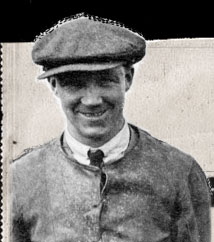
Herbert 'Bert' le Vack was a motorcycle world speed record holder throughout the 1920s and earned the nickname the 'Wizard of Brooklands' for his exploits at Brooklands.

Jarvis & Sons Limited were South London-based motor dealers for Morris and MG, and latterly coachworks providing special bodies for various car chassis until after World War II.

The BMW WR 750 was a supercharged racing motorcycle from BMW with two-cylinder, four-stroke flat twin engine that was first built in 1929, and developed through 1935 solely for racing by the factory.
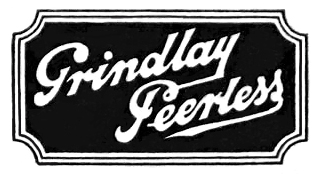
Grindlay Peerless is a historic motorcycle manufacturer that operated out of Coventry, England, throughout the early 20th-century, specialising in racing machines including the record breaking 498cc Grindlay Peerless.
